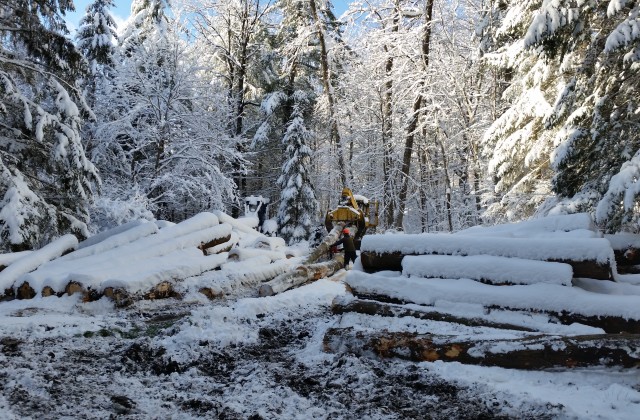Landowners Make Clear-Cuts to Benefit Rare Cottontail Rabbit
Norfolk area to create 28 acres of new “rabittat”
By Wiley Wood
This winter, two separate tracts of forest are being clear-cut in the Norfolk area to make habitat for the rare New England Cottontail.
At the corner of Wangum and Canaan Mountain roads, an 18-acre parcel belonging to Great Mountain Forest (GMF), is being logged. Only shrubs of three inches in diameter or less are being left, along with some apple trees and hawthorns.
Conditions are ideal, says Bronson, as heavy equipment can pass over the hard-frozen ground without leaving ruts. A feller buncher—a mechanized harvester that bunches the stems of several trees together as it fells them—sits at the roadside next to a stack of timber logs, its cutting parts gleaming.
The land looks naked now, concedes GMF’s forester, Jody Bronson. “I call it logging in the raw,” he says. Only the brush, gathered in piles, will provide any cover for rabbits. But in three or four years, the stumps and brush piles will fade behind the dense tangle of regenerating forest. And that transitional habitat, the thick flush of new growth that sprouts in the wake of clear-cutting, is what New England Cottontails need.
The New England has smaller eyes than the Eastern Cottontail, the introduced species that is replacing it, and its relatively poor peripheral vision and vulnerability to predators keep it largely inside the dense, brambly thickets of early successional forest. The cottontails that are commonly seen on lawns and golf courses are all Easterns.
The two species can’t be reliably distinguished in the field, says Bronson, but genetic analysis of pellet samples has confirmed the presence of New England Cottontails near GMF. The species is extinct in Vermont, virtually nonexistent in New Hampshire and Massachussetts and survives in just a few pockets in Connecticut, which is known as the species’s last remaining stronghold.
The 18-acre plot in GMF will be monitored by wildlife biologists of the New England Cottontail Initiative, which is jointly sponsored by the Connecticut Department of Energy and Environment, the U.S. Fish and Wildlife Service and the Department of Agriculture’s Natural Resources Conservation Service.
The GMF clear-cut will be at its peak as cottontail habitat in three or four years, when the stem count per acre may reach 12,000 stems. By comparison, a mature forest has a stem count of 200 to 300 stems per acre. In 12 to 18 years, the plot will be reverting to young forest. “It goes through a stem exclusion phase,” Bronson explains, “but we’ll start another plot in three or four years, before the first one burns itself out.” That corner of the forest, Bronson says, has always been managed for wildlife.
In another part of Norfolk, on the north slope of Haystack Mountain, John Cox is overseeing a similar project on 10 acres of his family’s land. “It doesn’t look like much now, but give me three or four years,” he says, standing over the mangled worksite where a dark stand of white pines was standing only weeks ago. An arborist, he reels off a list of the plants he hopes to see growing here in profusion soon—blueberry, blackberry, viburnum, azalea. “This is the Garden of Eden,” says Cox.
The 70-acre tract was bought as stumpland by his great-grandfather, Dr. Bulkeley, in the early 1890’s. A dermatologist and a pioneering forester, he worked at restoring the plot with his son-in-law, Edward Cox, planting 25,000 Scotch pines in the 1910’s. The state tried to buy the property, a pie-shaped wedge that rises to the top of Haystack, for its state park system, but the Coxes held onto it, and the descendents of Dr. Bulkeley—now 134 in number—continue to own it as the Roughland Group.
In the 1980’s, the family almost sold the land for development—two large building sites high on the side of Haystack—but the deal fell through. Now John Cox is steering the family toward preserving the acreage as a piece of wilderness they can call their own. “Being able to go into the woods and cut down a tree and have a campfire,” says Cox, “to me, that’s huge.” And making habitat for an endangered rabbit jibes with the family’s long-held conservation ethic.
Photo by John Cox.

